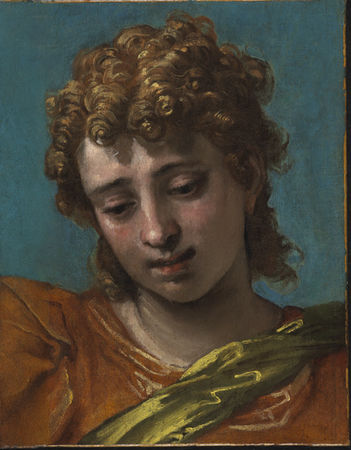"Paolo Veronese: The Petrobelli Altarpiece " @ The Blanton Museum of Art
Austin, TX– The Blanton Museum of Art at the University of Texas at Austin announces an important discovery regarding a work by Venetian master Paolo Veronese (1528 – 1588). Head of an Angel, a painting in the Blanton's permanent collection, was recently identified as a fragment of a long-lost masterpiece by Veronese. The identification was made by Dr. Xavier Salomon, a Veronese expert and curator of the Dulwich Picture Gallery outside London. While conducting research for an upcoming exhibition, Salomon began to suspect that the Blanton painting was in fact the head of Saint Michael, the central figure in the so-called Petrobelli altarpiece, created around 1565, at the height of the artist's career. Recent X-rays and other tests performed by Stephen Gritt, conservator at the National Gallery of Canada, Ottawa, confirmed this hypothesis. Three other fragments from the altarpiece had been previously identified in the collections of Dulwich, Ottawa, and the National Gallery of Scotland, Edinburgh. These works, along with the Blanton's newly identified Saint Michael, are currently undergoing treatment and will be reunited for the first time in more than two centuries. The reconstructed altarpiece will be exhibited, along with corresponding x-rays, first in Dulwich in February 2009, and then in the exhibition, Paolo Veronese: The Petrobelli Altarpiece opening in Austin on September 27, 2009.
While the Blanton's painting had always been recognized as a fragment from a larger work of Veronese's mature activity, Salomon suspected that it might correspond to the figure of Saint Michael that once stood at the center of the altarpiece. One of three paintings by Veronese at the Blanton, the work was acquired in 1998 as part of the Suida-Manning Collection, which had been one of the finest collections of Old Master paintings and drawings in private hands, including important works by Correggio, Parmigianino, Rubens, Vouet, Lorrain, Ricci and Tiepolo. The acquisition not only transformed the museum's holdings but connected the Blanton with major American and European institutions and their projects. This discovery and the painting's role in an international exhibition are only the latest examples. Jonathan Bober, the Blanton's curator of prints, drawings and European paintings states, “We are elated by this discovery and struck by its implications. Thanks to Salomon's wonderful intuition and diligent investigation, we now understand the specific context, function, and quality of the work. The identification of the visual and iconographic core of a major project by one of the greatest painters of the sixteenth century is no small thing.”
Paolo Veronese, The Petrobelli Altarpiece, circa 1565 (digital reconstruction). Left: Saint Anthony Abbot and Antonio Petrobelli (London, Dulwich Picture Gallery). Top: Dead Christ Supported by Angels (Ottawa, National Gallery of Canada). Right: Saint Jerome and Girolamo Petrobelli (Edinburgh, National Gallery of Scotland). Center: Saint Michael (Austin, Blanton Museum of Art)
Around 1565 Veronese was commissioned to do the altarpiece by the cousins Antonio and Girolamo Petrobelli for the church of San Francisco at Lendinara, a small town near Padua. The resulting painting depicted each cousin with his patron saint at the sides of the composition, Saint Michael at the center, and the Dead Christ supported by angels above. One of the largest altarpieces in the sixteenth-century Italy, measuring over five meters high, it was cut down and sold in pieces when, following the suppression of the Franciscan Order, the church was closed in 1788. Writing in 1795 about the altarpiece and its dismemberment, the local historian Giovanni Battista Sasso noted that, “It was sold in quarters, as one does with butcher's meat.” Dulwich acquired its piece in 1811. After passing through various English hands, the pieces at Edinburgh and Ottawa arrived in the early twentieth century. The intervening history of the Blanton's fragment is unknown before 1938, when it was published by William Suida.
For the Dulwich exhibition, which will the travel to Ottawa, the altarpiece will be reconstructed and exhibited alongside X-rays and blown up details of the work. Salomon has recently presented his research and this disocovery at the National Gallery of Art, London, and is preparing it for publication in The Burlington Magazine. This important discovery reinforces the treasures within the Suida-Manning collection and provides an excellent opportunity to re-evaluate this important work.
The Blanton Museum of Art at The University of Texas at Austin is one of the foremost university art museums in the country, and has the largest and most comprehensive collection of art in Central Texas. The museum welcomes and engages all visitors by offering personal, extraordinary experiences that connect art and ideas, reaching within and beyond the university to stimulate the thriving, creative community that is Austin, Texas. The Blanton's permanent collection of more than 17,000 works is recognized for its European paintings, an encyclopedic collection of prints and drawings, and modern and contemporary American and Latin American art. visit www.blantonmuseum.org

/https%3A%2F%2Fprofilepics.canalblog.com%2Fprofilepics%2F1%2F0%2F100183.jpg)
/https%3A%2F%2Fstorage.canalblog.com%2F03%2F02%2F119589%2F96711876_o.jpg)
/https%3A%2F%2Fstorage.canalblog.com%2F11%2F31%2F119589%2F94773502_o.jpg)
/https%3A%2F%2Fstorage.canalblog.com%2F20%2F83%2F119589%2F94772815_o.jpg)
/https%3A%2F%2Fstorage.canalblog.com%2F26%2F72%2F119589%2F75604929_o.jpg)
/https%3A%2F%2Fstorage.canalblog.com%2F59%2F60%2F119589%2F26458628_o.jpg)




/http%3A%2F%2Fstorage.canalblog.com%2F27%2F73%2F119589%2F129441711_o.jpg)
/http%3A%2F%2Fstorage.canalblog.com%2F76%2F12%2F119589%2F122078065_o.jpg)
/http%3A%2F%2Fstorage.canalblog.com%2F33%2F35%2F119589%2F120637381_o.jpg)
/http%3A%2F%2Fstorage.canalblog.com%2F42%2F87%2F119589%2F120483229_o.jpg)